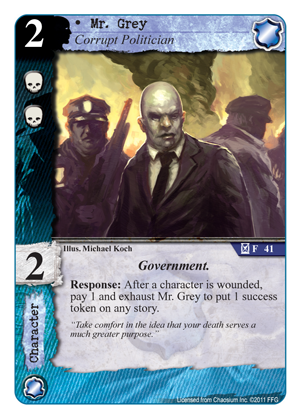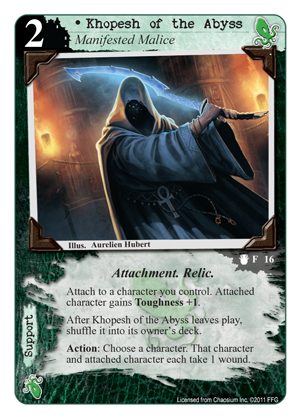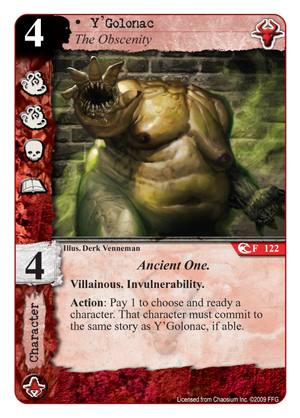Title: FFG:Calling Down the Ancients in Munich
Post by: RSSFeeder on 10 June 2012, 08:30:04
A Call of Cthulhu Tournament Report by Guest Writer Francesco Zappon

Dear Cultists and Investigators,
I present, here, my personal report of the 2012 German Regional Championship tournament, held in Munich, where twelve players competed to win the title of German Call of Cthulhu: The Card Game Regional Champion 2012.
The deck I decided to bring to Munich for the German regional was basically an updated version of the deck I’ve been playing in the past. Of course, the meta has evolved since then, with the release of new cards and a new restricted list. Accordingly, the deck saw some changes, too, most notably the addition of another faction!
Shub-Niggurath
3x Grasping Chthonian (Initiations of the Favored, 51)
3x Thunder in the East
3x Y'Golonac (Core Set, 122)
3x Ghoulish Predator
3x Twilight Cannibal
Cthulhu
3x Deep One Rising
3x Sacrificial Offerings (Core Set, 59)
3x Innsmouth Troublemaker
2x Carl Stanford
3x Khopesh of the Abyss (The Shifting Sands, 16)(Restricted)
3x Dreamlands Fanatic
 Yog-Sothoth
Yog-Sothoth
3x Many-angled Thing (The Gleaming Spiral, 99)
3x Calling Down the Ancients (Secrets of Arkham, 32)
3x A Single Glimpse
3x Gathering at the Stones
3x Initiation of Glaaki
Order of the Silver Twilight
3x Master of the Myths
Total: 50 cards
The deck can be a bit tricky to play. It is fundamental that you start resourcing with three different factions on the three domains as soon as possible, and while you build up, the Master of the Myths helps you through the early turns by defending or attacking stories.
The simple rule is you play the deck waiting. In the early turns, you want to take full advantage of your removals like Sacrificial Offerings and Calling Down the Ancients, and the best way to do that is if you have none of your characters in play. When do you play your characters? You can start playing characters when you have played all or most of the removals in your hand, and you need characters to defend the stories. Also, you eventually have to put pressure on your opponent; usually, around turn six or seven, the board should be pretty clean, and Y'golonac should come to help finish the match.
I chose to play this deck because it offers a possible answer to almost everything my opponent could play. Of course, there are some corners that are not fully addressed. My guess was that no one would play a discard deck based around Glimpse of the Void (Spawn of Madness, 14), and I was right. I also guessed that the meta would be filled with supports and attachment, though here I was only partially right. Were there other options? Of course. A true rush deck would have probably fared even better than this one. A lot of the decks were built following the same line I adopted, and a well-built rush deck could have won the game well before I could establish complete board control. A Glimpse of the Void deck would have been another good choice. I thought about these other decks before the tournament, but didn’t choose them because of a lack of testing. In a tournament, it's not always important to play the “best” deck, but to play the deck with which you feel more familiar. I had been playing this deck for a long time, since the time I won the Stahleck tournament in 2010. The deck had evolved, but the philosophy behind it stayed the same. I felt comfortable playing this deck; it was almost automatic.
Match Play
Round 1: Ulrich
Unfortunately, I have to play immediately against Ulrich, the tournament organizer. However, my deck worked as expected. He was playing a mono-Cthulhu deck that should have played Ancient Ones very quickly. The problem was that the quantity of my removals was greater than his acceleration. The game was ultimately decided when, after winning my first story, I triggered its effect, bouncing a Many-angled Thing into my hand, then playing it to remove another of Ulrich’s characters the next turn. I ended up wining three stories to his zero.
Round 2: Wolfgang
Wolfgang is the organizer of the Stahleck event in Germany, and I’ve known him for quite some time. In this match, I made a mistake that I was lucky didn’t cost me the game. We resourced, and I saw that he was playing a deck with Yog-Sothoth, Miskatonic, and Hastur. Moreover, I saw supports. Even though I saw this, I decided, on the first round, to resource a Grasping Chthonian. What was I thinking? He managed to steal two of my characters, so I was forced to destroy my own characters with my own removals! I managed to win, anyway, because he was lacking characters and mine had better icons. Y’golonac helped finish the game, and again, I won with three stories to zero.
Round 3: Vincent
Three rounds into the event, and I have faced three people I knew before the tournament! Vincent is my playtest partner, and I know that I have to expect some cool and dangerous interaction. Knowing this, I decided to play the match waiting for his moves. In the first three to four rounds, we both resourced and passed without playing any cards. He was playing a deck with Agency, Cthulhu, and Yog-Sothoth. At some point, he played Mr. Grey (Conspiracies of Chaos, 41), and that is when I decided to start. I destroyed Mr. Grey with a Sacrificial Offerings, responded by bringing in a Dreamlands Fanatic, and then played Y'Golonac and another character in the next round. Again, I pressed slowly for stories and kept the board clean along the way to another win.
Round 4: Nico
Someone new! He was playing a mono-Hastur deck, as I understood from looking at his initial resources. In this game, though, I ran into a problem of resources and didn’t see any Yog cards until turn five or six. I was only saved because I drew first one, then two, copies of the Master of Myths. Meanwhile, one use of Khopesh helped me clean the board, even though I had to destroy my character. Finally, Yog cards and Y'golonac arrived to close the match. Nico is a good player, and he managed to destroy my first Y'Golonac with Ice Shaft (Never Night, 83) and a Demon Lover (Core Set, 84) to reduce his skill. Unfortunately, Gathering at the Stones brought him right back, and I finished the game with three stories to his one, making the Top 4, undefeated.
Semifinal: Paul
Paul is a new player and this is his first tournament, but he plays really well. If he didn't tell me this was his first tournament, I would have believed that he had a lot of experience. He made no mistakes, and he outperformed me with a clear victory, three stories to my zero.
Moreover, in this game, I arrived to the conclusion that the Khopesh of the Abyss is, at most, a situational card. I only used the Khopesh in one game out of the five I played, and even in that case, I would have won without it. In the semifinal, I decided to play an early Khopesh, getting it onto the table turn one with an Innsmouth Troublemaker. This decision forced me to resource other removals and characters cards. I don't want to say that this cost me the game, because Paul fully deserved his victory, but the decision certainly influenced the course of my actions for the rest of the match.
 I defeated Vincent in the third place match, finishing third for the second consecutive tournament, and I watched Paul win the tournament. Well done!
I defeated Vincent in the third place match, finishing third for the second consecutive tournament, and I watched Paul win the tournament. Well done!
Reflections on the Khopesh of the Abyss
I think a lot of people are more worried about this card than they should be. I claim that the Khopesh is, at most, a situational card. The greatest merit of the Khopesh, in my opinion, is that it has made people more aware of attachment and support cards, and this is positive for the game. If it wasn't the Khopesh, it would have been Stygian Eye (Into Tartarus, 96) to have the same effect. Both cards are clearly good, but saying that they deserve to be banned or restricted is for players who cannot adapt. The positive thing about Khopesh and Stygian Eye is they change the metagame. From now on, you have to consider the Khopesh while building your deck. This means you have to consider attachment and support cards, adding another dimension to game play.
Finally, I want to say a very big thank you to the organizer of the event, Ulrich Hergl. The organization was impeccable, and the judging was precise and clear. Thank you!
–Francesco Zappon, Third Place Call of Cthulhu Munich Regional Championship 2012
...Source: Calling Down the Ancients in Munich (http://www.fantasyflightgames.com/edge_news.asp?eidn=3343)




